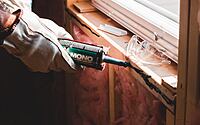DIY Window Repairs: What You Can Handle and When to Call a Pro
Looking out through a cracked or drafty window not only robs your home of curb appeal but also allows energy loss and invites critters or moisture inside. While some window repairs like replacing a loose screen or sticky sash are straightforward DIY projects, others like reglazing or replacing broken glass require experience to avoid injury or further damage. This article provides tips on basic window maintenance you can handle yourself as well as signs that it’s time to call in a professional for window repair. You’ll learn how to fix common issues like broken sash cords or stuck windows and determine when problems like rotting wood, faulty weatherstripping, or cracked glass call for an expert. With the right know-how, you can solve simple window issues on your own time and budget yet recognize what’s best left to the pros.
Simple DIY Window Repairs
Sticky windows
Has opening or closing your windows become a struggle? Sticky windows are often caused by built-up dirt, dried paint, or other debris in the window tracks. Signs include windows that are difficult to open, scrape, or catch when you raise or lower them, or no longer slide smoothly. To fix it, you’ll need a plastic putty knife, vacuum attachment, soap and water, and lubricant spray. Carefully scrape out built-up gunk, then use the vacuum to remove loose debris. Clean the tracks with soapy water, then dry thoroughly. Finally, apply a silicone or lithium grease spray lubricant to the tracks per the product instructions. Avoid using too much lubricant or spreading it onto the window glass itself. With some elbow grease and the proper supplies, you can get your windows sliding like new again. Just do not force sticky windows open or closed to avoid damage.
Drafts
Feeling cold drafts from your windows? Drafts are often caused by gaps in the window seals. Signs include feeling cold air coming through, seeing daylight around the frame, and noticing condensation or frost buildup. To fix this, you’ll need new weatherstripping or caulk to reseal gaps. Remove old, worn seals and clean the contact areas. Measure and cut seals to size. For weatherstripping, press into place along the sash and frame. For caulk, apply thin beads in any narrow cracks. Tool the caulk smooth. Replace and stop molding if loose. Avoid over-caulking, as too much sealant can make the window stick. Also ensure any new weatherstripping isn’t too thick, or it could prevent the window from shutting fully. With fresh seals and caulk, your windows will once again block out drafts.
Foggy glass
Seeing cloudy, foggy spots on your windows? This fogginess is often caused by mineral deposits left by hard water or failed seals allowing moisture between the panes. Signs are cloudy spots or streaks that obstruct visibility. To fix it, you’ll need glass cleaner, vinegar, and towels. Carefully clean inside and out with a vinegar and water solution using a microfiber cloth. For light deposits, use glass cleaner. If there are broken seals between panes allowing moisture inside, you may need to order custom windows online or hire a pro. Avoid using harsh cleaners that could scratch glass. Don’t try to take apart double-paned windows yourself. With routine cleaning, minor fogginess can be improved, but damaged seals likely mean a window unit replacement. Protect your view and let the light shine through again.
Loose hardware
Rattling, shaking, and misaligned windows are often signs that the hardware is loose. This includes items like handles, sash locks, and hinges that attach the sash to the frame. Loose hardware can cause air leaks, prevent the window from shutting tightly, and even lead to broken sealant around the frame. To tighten loose hardware you’ll need several tools – a screwdriver, drill, replacement hardware if necessary, wood filler, and emery cloth or sandpaper. Carefully tighten all visible screws on handles, sash locks, and hinges. Replace any missing or broken hardware. For loose hinges, remove screws, fill old holes with wood filler, sand smooth, and re-drill pilot holes before reattaching the hinges tightly. Take care not to over-tighten screws or strip them by using the proper-sized screwdriver. Keeping hardware securely fastened will help windows operate smoothly.
Cracked glass
Over time, window glass can develop cracks from thermal stress or impact. Signs are visible lines or fractures in the glass. For small cracks, you can use a clear-drying epoxy resin adhesive to repair it. Larger cracks will require replacing the glass pane. To fix with epoxy, start by cleaning the crack. Mix a small amount of epoxy and use a toothpick to fill in the crack. Smooth it flush and wipe away excess. Allow to fully cure before disturbing, usually 24-48 hours. Avoid getting epoxy on the frame sealant. Also, take care not to use adhesive on very large cracks—these require professional glass replacement to prevent cracks from spreading. With some simple DIY epoxy, you can repair minor window glass cracks but don’t take risks with major damage. Get cracked window panes replaced right away.
Screen repairs
Over time, window screens can develop holes or tears from wear, pets, weather, and more. Signs are obvious holes or rips that allow bugs and debris to enter. For small holes, you can patch them temporarily with screen patching kits. Larger holes and tears will require re-splining the screen frame or fully replacing the screen. To do this, you’ll need a spline cord, spline roller tool, utility knife, and screen material. Remove the old screen and spline. Cut the new screen several inches larger than the frame. Insert the spline cord in the screen channels, then press the screen into the channel using a spline roller to secure it. Trim excess screen. Avoid making the screen too tight or loose in the frame. Also, take care not to damage the screen with the roller. Proper spline repair or replacement will restore your window screens to keep out pests.
Complex Repairs for Professionals
Some window issues should only be handled by qualified technicians, like rotting sills or frames, replacing entire units, interior leaks, broken counterbalances, and failed double pane seals. Rotting wood around sills and frames causes decay, invites pests, and compromises structural integrity. Signs include soft, crumbly wood, peeling paint, or visible mold. Attempting DIY sill replacements risks damaging weatherproofing or supports. Hiring a pro to replace sills or entire frames can cost $200-1,000 but ensures proper installation and materials.
Windows with persistent leaks around poorly sealed panes can lead to interior damage like peeled paint, warped sills, and mold growth. Proper sealing is crucial but challenging for amateurs to achieve neatly. A full window replacement by a contractor averages $400-800 but eliminates leaks permanently.
Broken counterbalance mechanisms in double-hung windows will cause sashes to fall suddenly when opened. Repairing these requires special disassembly skills to avoid shattering the glass or wounding yourself. Pro technicians have the expertise to replace mechanisms and properly balance sash weights again for $150-300 per window.
Failed seals on double-pane glass allow air and moisture between panes, leading to internal fogging and reduced insulation. DIY seal replacements rarely achieve a permanent fix. Hiring an expert to replace the pane or full window properly runs $250-500 but restores appearance and efficiency.
Some repairs like these require specialized tools, materials, and skills that go beyond average DIY abilities. Consult professional window contractors when issues involve structural components, weather seals, or glass integrity. Their expertise allows comprehensive fixes and better home protection.
When to Call a Professional
Some window repairs are best left to the professionals. If the issue affects home safety or security, like broken locks or cracked glass, it’s best to hire an expert. You should also call a pro window installer if you lack specialty tools or skills needed for complex repairs like sash cord replacement or fixing broken counterbalances. Whole window replacement is a job for contractors since new units like buy tilt and turn windows must be properly measured and installed. If you can’t diagnose the root cause of a problem or the fix seems tricky, don’t risk it—contact a window company to have it repaired correctly.
Conclusion
Regular window maintenance and minor DIY repairs can save money while keeping your windows functioning properly. However, it’s important to recognize issues that require professional expertise. Calling in a skilled window contractor when major repairs are needed ensures your home’s windows remain secure, efficient, and structurally sound.
- by Matt Watts



